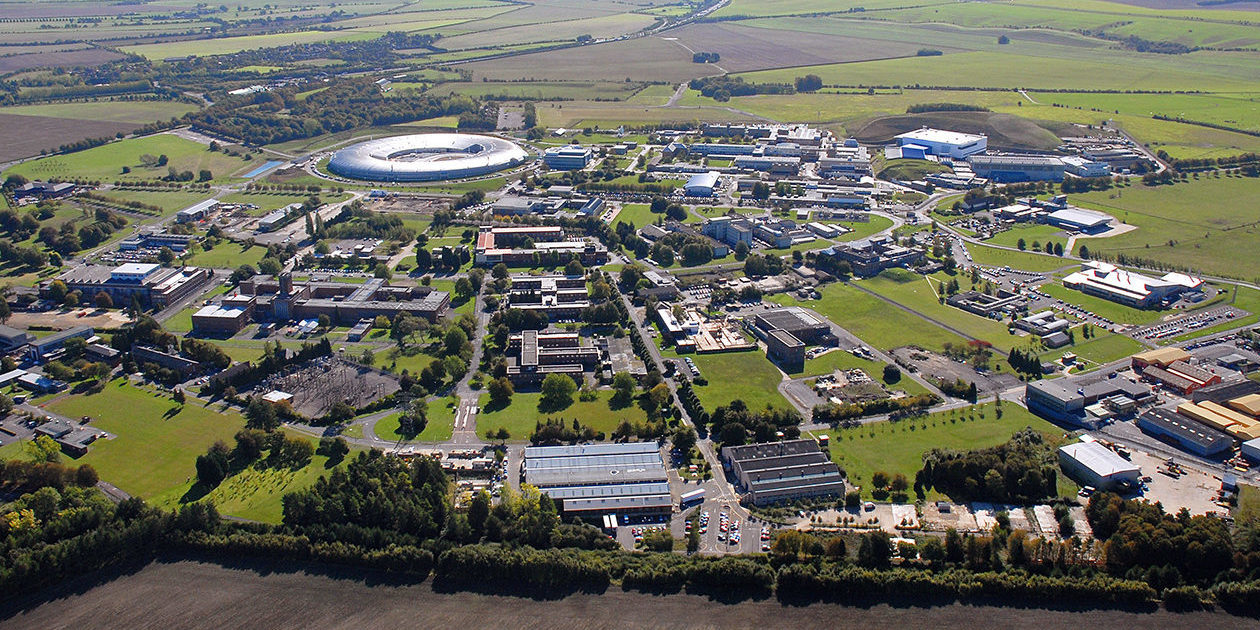What is Harwell Campus?
Harwell Campus is a science and technology hub and home to approximately 240 organisations employing over 5500 people. It’s also known as the Harwell Science and Innovation Campus and the Harwell Science Park. The campus is 12 miles south of Oxford on the A34, between M40 and M4, close to the towns of Didcot, Harwell, Chilton and Oxfordshire. It is part of Science Vale.

Harwell Campus brings together over £2bn worth of world-leading research infrastructure, attracting Universities from around the world alongside public-sector organisations and large and small companies across space, energy and environment, physical sciences, life sciences, engineering and big data.
The research infrastructure includes the Diamond Light Source (UK’s national synchrotron), RAL Space, the ISIS Neutron Source, the Central Laser Facility, the National Imaging Centre, the Research Complex at Harwell, and the EMERALD and JASMIN supercomputers and data centre. Organisations include The Science & Technology Facilities Council (STFC), European Space Agency (ESA), Medical Research Council (MRC), Public Health England, the Satellite Applications Catapult and the UK Space Gateway.
The forthcoming Rosalind Franklin Institute will be at the heart of Harwell’s Healthtec cluster, and the new Energytec cluster has been announced with the Faraday Institute on campus.
The 710-acre campus has a master plan to deliver 5 million sq. ft. of new buildings for science and technology companies, alongside new amenities and housing. In 2017 the campus transacted on over 180,000 sq. ft. of new buildings, with an ongoing rolling programme of offices, laboratories, R&D and industrial units.
Why is Harwell Campus Important?
Harwell Science Park has been the site of many landmark scientific advances such as the launch of the world’s first transistorised computer and Europe’s first energy-producing fission reactor. The great minds that brought these projects to fruition were able to do so with the right space, equipment, support and funding throughout each phase of their work.
Harwell Campus is a science community, creating the environment for people to meet and interact either informally or at numerous networking events, or in one of the sports clubs.
Open access facilities on the campus include:
- Multidisciplinary laboratories
- Test facilities Instrument and mission design
- Laser facility Nanoscale imaging
- Super microscopes for atomic-level study
- Supercomputers for data analysis and bioinformatics
Other campus amenities include:
- Sports facilities
- Cafés, a mini supermarket and pop‑up food stalls
- Nurseries
- A post office
The campus is also home to the Harwell Space Cluster, where 80 leading space organisations conduct public and private research and development; and the HealthTec Cluster, with over 1000 people working towards healthcare-related breakthroughs.
Harwell Campus and the Local Economy
A 2017 Science and Innovation Audit (SIA) was conducted in Oxfordshire and found that the city could play a key role in driving the UK’s economy forward through technologies like digital health, space and satellites, autonomous (self-driving) vehicles, and quantum computing. It’s estimated that these four technologies could be worth up to £180billion by 2030.
Nigel Tipple, Chief Executive of the Oxfordshire Local Enterprise Partnership (OxLEP), said, “Many professional organisations view Oxfordshire as a global asset, underpinning the UK economy and a place of opportunity for residents and businesses alike.”
With businesses at Harwell Campus driving the growth of these key technologies, the local economy has been growing in its national significance.
Future Growth of Harwell Campus
With more organisations taking up residence every year, the Harwell Innovation Campus has begun an expansion plan to accommodate future demand. The plan includes new working and research space, hundreds of new homes for employees and improved amenities.
The campus has identifiable clusters which are also expanding, namely HealthTec, EnergyTec, Space and the University Quarter.
Notable Companies at Harwell Campus
Organisations and individuals working at Harwell Innovation Centre have made amazing, ground-breaking discoveries over the years.
A few of the highlights include:
- 1947: GLEEP test reactor generates nuclear energy for the first time in Europe
- 1953: CADET, the world’s first transistorised computer is launched
- 1954: ZEPHYR, the world’s first experimental ‘fast’ reactor is established
- 1961: Dr Mary Lyon discovers X chromosome inactivation
- 1985: Harwell earns over £50M p.a. from 1200 R&D contracts
- 1992: Computer scientists at Harwell discover the world’s largest prime number
- 2007: The Diamond Light Source Synchrotron produces its first user beam
- 2014: ESA’s Rosetta mission lands the Philae probe on the surface of a comet
- 2018: The Faraday Institution HQ is established at Harwell
Bidwells are UK property experts with specialised knowledge in the field of science and technology properties and are tasked at Harwell with providing occupational agency, project management and asset management.
Harwell Campus is a science and technology hub and home to approximately 240 organisations employing over 5500 people. It’s also known as the Harwell Science and Innovation Campus and the Harwell Science Park. The campus is 12 miles south of Oxford on the A34, between M40 and M4, close to the towns of Didcot, Harwell, Chilton and Oxfordshire. It is part of Science Vale.
